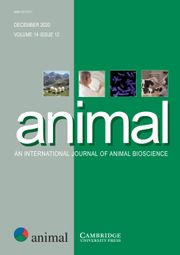Crossref Citations
This article has been cited by the following publications. This list is generated based on data provided by
Crossref.
Colombo, Eduardo A
Cooke, Reinaldo F
Brandão, Alice P
Wiegand, Jacob B
Schubach, Kelsey M
Sowers, Consuelo
Duff, Glenn C
Gouvêa, Vinicius N
and
Cappellozza, Bruno I
2020.
Administering an appeasing substance to optimize welfare and performance of receiving cattle1.
Translational Animal Science,
Vol. 4,
Issue. Supplement_1,
p.
S1.
Angeli, Beatriz
Cappellozza, Bruno
Moraes Vasconcelos, José Luiz
and
Cooke, Reinaldo Fernandes
2020.
Administering an Appeasing Substance to Gir × Holstein Female Dairy Calves on Pre-Weaning Performance and Disease Incidence.
Animals,
Vol. 10,
Issue. 11,
p.
1961.
Schubach, Kelsey M
Cooke, Reinaldo F
Brandão, Alice P
Rett, Bruna
Ferreira, Vitor
Scatolin, Giovanna
Colombo, Eduardo A
Daigle, Courtney L
Pohler, Ky G
and
Cappellozza, Bruno I
2020.
Administering an appeasing substance to beef calves at weaning to optimize welfare and productivity.
Translational Animal Science,
Vol. 4,
Issue. Supplement_1,
p.
S74.
Schubach, Kelsey M
Cooke, Reinaldo F
Daigle, Courtney L
Brandão, Alice P
Rett, Bruna
Ferreira, Vitor S M
Scatolin, Giovanna N
Colombo, Eduardo A
D’Souza, Genevieve M
Pohler, Ky G
and
Cappellozza, Bruno I
2020.
Administering an appeasing substance to beef calves at weaning to optimize productive and health responses during a 42-d preconditioning program.
Journal of Animal Science,
Vol. 98,
Issue. 9,
Colombo, Eduardo A
Cooke, Reinaldo F
Brandão, Alice P
Wiegand, Jacob B
Schubach, Kelsey M
Duff, Glenn C
Gouvêa, Vinícius N
and
Cappellozza, Bruno I
2020.
Administering an appeasing substance to optimize performance and health responses in feedlot receiving cattle.
Journal of Animal Science,
Vol. 98,
Issue. 11,
Hervet, Caroline
Boullier, Justine
Guiadeur, Marlène
Michel, Léa
Brun-Lafleur, Laure
Aupiais, Anne
Zhu, Jianzhong
Mounaix, Béatrice
Meurens, François
Renois, Fanny
and
Assié, Sébastien
2021.
Appeasing Pheromones against Bovine Respiratory Complex and Modulation of Immune Transcript Expressions.
Animals,
Vol. 11,
Issue. 6,
p.
1545.
I. Cappellozza, Bruno
and
S. Marques, Rodrigo
2021.
Meat and Nutrition.
Colombo, E.A.
Cooke, R.F.
Brandão, A.P.
Wiegand, J.B.
Schubach, K.M.
Sowers, C.A.
Duff, G.C.
Block, E.
and
Gouvêa, V.N.
2021.
Performance, health, and physiological responses of newly received feedlot cattle supplemented with pre- and probiotic ingredients.
Animal,
Vol. 15,
Issue. 5,
p.
100214.
Marcet-Rius, Míriam
Mendonça, Tiago
Pageat, Patrick
Arroub, Sana
Bienboire-Frosini, Cécile
Chabaud, Camille
Teruel, Eva
and
Cozzi, Alessandro
2022.
Effect of wither application of an analogue of pig appeasing pheromone on encounters between unfamiliar mini-pigs.
Porcine Health Management,
Vol. 8,
Issue. 1,
Vieira, Douglas Gomes
Vedovatto, Marcelo
Fernandes, Henrique Jorge
Lima, Eduardo de Assis
D’Oliveira, Marcella Candia
Curcio, Uriel de Almeida
Ranches, Juliana
Ferreira, Matheus Fellipe
Sousa, Osvaldo Alex de
Cappellozza, Bruno Ieda
and
Franco, Gumercindo Loriano
2023.
Effects of an Appeasing Substance Application at Weaning on Growth, Stress, Behavior, and Response to Vaccination of Bos indicus Calves.
Animals,
Vol. 13,
Issue. 19,
p.
3033.
Vieira, Douglas Gomes
Vedovatto, Marcelo
Ferreira, Matheus Fellipe
Ranches, Juliana
Cappellozza, Bruno Ieda
de Sousa, Osvaldo Alex
Canuto, Nelson
de Nadai Bonin Gomes, Marina
and
Fernandes, Henrique Jorge
2024.
Appeasing Substance Administration at Feedlot Entry Impacted Temperament, Pen Behavior, Immunocompetence, and Meat Quality of Beef Heifers.
Animals,
Vol. 14,
Issue. 23,
p.
3517.
Kvamme, Keenan
Marques, Rodrigo S
Alves Cruz, Vinicius
Limede Cintra, Arnaldo
Ogg, Makayla Anne
McCoski, Sarah R
Posbergh, Christian J
Bradbery, Amanda N
Mercadante, Vitor R G
Mackey, Shea J
Pickett, Autumn T
and
Cooke, Reinaldo F
2024.
Multiple administrations of bovine-appeasing substance during a 42-d preconditioning program followed by feedlot receiving and its effects on physiologic, health, and performance responses of feeder cattle.
Journal of Animal Science,
Vol. 102,
Issue. ,
Santos, Mariana
Oliveira, Dalton Mendes de
de Souza, Matheus Rodrigues
Almeida, Gabrielly Benevides de
Santos, Aylpy Renan Dutra
Belmonte, Juliano Cesar Castro
Melo-Sterza, Fabiana de Andrade
Ferraz, André Luiz Julien
and
Vedovatto, Marcelo
2025.
Impact of Two-Stage Weaning and Bovine-Appeasing Substance on Growth, Temperament, Pasture Behavior, and Immune System of Nellore Calves.
Animals,
Vol. 15,
Issue. 11,
p.
1640.
Garcia-Alvarez, J.
Teruel, E.
Cozzi, A.
Harris, E.
Rutter, S.M.
and
Beaver, A.
2025.
Effects of a synthetic analog of the bovine appeasing pheromone on the overall welfare of dairy calves from birth through weaning.
Journal of Dairy Science,
Vol. 108,
Issue. 2,
p.
1964.
Gellatly, Désirée
Lei, Yaogeng
Neale, Alison
Smith, Lyndsey
Edgar, Emilie
Bloomfield, Brittany
Elliot, Brianna
Wenger, Irene
and
Thompson, Sean
2025.
Impacts of Maternal Bovine Appeasing Substance Administered at Weaning on Behavioral and Physiological Adaptation of Beef Heifers to the Feedlot.
Animals,
Vol. 15,
Issue. 19,
p.
2788.
Cooke, Reinaldo F
Mackey, Shea J
de Souza, Izadora S
Mello, Ingo A S
Barreto, Yasmin M
and
Gouvea, Vinicius N
2025.
Administering the maternal appeasing substance to Bos taurus and B. indicus cattle placed as yearlings in feedlots with different environmental conditions.
Translational Animal Science,
Vol. 9,
Issue. ,
Spencer, J.A.
Duhatschek, D.
Piñeiro, J.
Hairgrove, T.
Daigle, C.
Cleere, J.
and
Cooke, R.F.
2025.
Evaluating the efficacy of maternal bovine appeasing substance in reducing stress and enhancing growth performance in dairy calves after disbudding.
Journal of Dairy Science,
R⊘rvang, Maria Vilain
Harainen, Erika
Högberg, Niclas
and
Stenfelt, Johanna
2025.
Cattle olfaction: Dairy cows' interest in odors and factors affecting their odor exploration behavior.
Journal of Dairy Science,
Vol. 108,
Issue. 6,
p.
6297.
Mussalafo, Denise E.
Vedovatto, Marcelo
Santos, Aylpy R. D.
Oliveira, Dalton M.
Sterza, Fabiana A. M.
Santos, Mariana
Batista, Helena B. C. R.
Garcia, Jaíne G.
and
Souza, Andréa R. D. L.
2025.
Use of Restricted Nursing and a Bovine Appeasing Substance on the Welfare, Growth Performance, and Response to Vaccination of Beef Calves at Weaning.
Animal Research and One Health,

